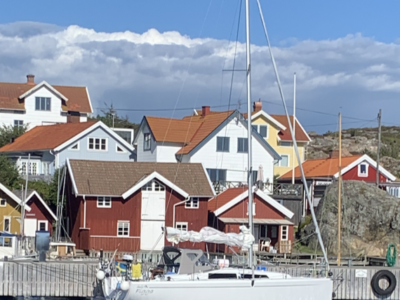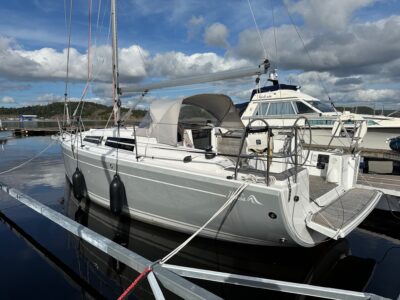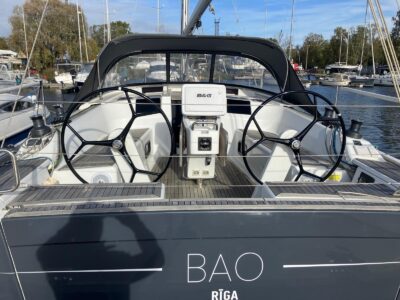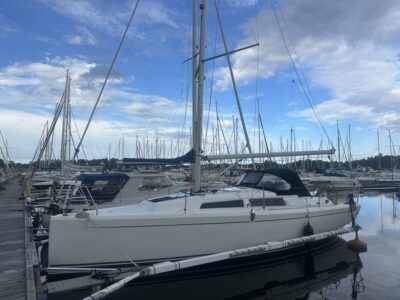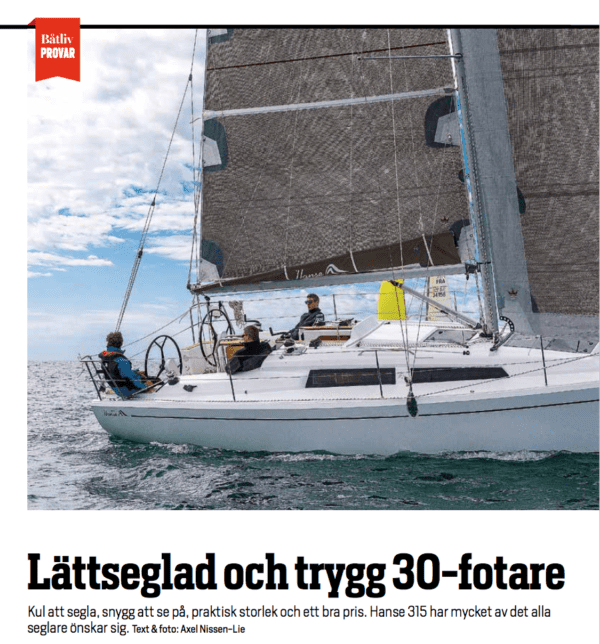 Smooth and safe 30-footer
Smooth and safe 30-footer
Fun to sail, great to look at, practical size and a good price. The Hanse 315 has much of what every sailor wants. Text & photo: Axel Nissen-Lie
WHICH HANSEMODEL are you most satisfied with?
We put this question to Matthias Broker, designer at Judel Vrolijk, who has contributed to the creation of esta of the shipyard’s models.
– The latest model is the best. It builds on past experience and is an improvement. But if I were to single out a single model, it would have to be the Hanse 315,” says Matthias Broker.
Without a doubt, the Hanse 315 has a good design. Launched in 2015, it was named “European Boat of the Year 2016”, an award given by a jury of twelve European yachting journalists.
It is risky to develop smaller sailing boats where price is an important element. As a result, few of the major yards have launched 31-foot boats in recent years.
– It’s complicated to achieve so much with a limited volume for a boat to be sold at a competitive price,” explains Matthias Broker.
The price starts at 868 500 SEK, which makes the boat competitive with used boats. But to be successful, it has to be more than just price. The boat must also have something that you can’t find on used boats.
WE SAILED THE BOAT in winds of 5-8 m/sec. The Hanse 315 has a hull that is more reminiscent of Dehler than Hanse with sporty and aggressive lines. With the large bulkhead drawn to the cockpit, this is the sportiest of Hanse’s models. The yard has not skimped on either sail area or keel weight.
One reason the boat looks so good is the construction. At the escalator, the standing height is 1.95 m, but here the shower is as low as possible. With low draft, the yard has also managed to reduce freeboard, weight and cost.
With Hanse’s acquisition of Dehler, Karl Dehler (son of Dehler’s founder) also joined Hanse. He is a 470 dinghy world champion, a regatta sailor and a skilled boat developer. Karl led the development of the Hanse 315, where his knowledge and opinions have been a positive contribution. The Hanse 315 fits well into the Hanse series. The solutions are based on the same philosophy as before, but the yard has raised the quality of the equipment with Seldén masts and quality equipment on deck.
The test boat was equipped with a membrane sail from Elv- stream. These help to give the boat a better sailing experience, especially on cruises. Personally, I would have opted for a 107 percent fock for better light wind conditions and racing, but that requires upgraded deck equipment.
Volume manufacturers are often criticised for saving costs by reducing the keel weight. The Hanse 315 has 1,500 kg of ballast, the Dufour 310 has 1,330 kg and the Beneteau Oceanis only 994 kg. However, the Hallberg-Rassy 310 has 1 680 kg. According to our GPS, we were sailing at six knots at a good altitude. The balance was good, here the dimensionally stable sails mean a lot. The grip of the rudder was excellent.
The Hanse 315 comes standard with a single helm, but the boat we sailed had twin helms, giving the same steering, feel and comfortable sailing benefits as larger boats. Although tiller roll would be preferable, the tiller roll in this boat is too far forward. The boat is designed for steering wheel control and this optimises the space best.
We sailed up to ten knots with a gennaker and the boat felt lively. Not as fast as the light French boats, but the Hanse 315 is better at cruising. The Hanse 315 is Hanse’s smallest model. For a boat of only 30 feet, there is plenty of room on board.
Wide hedge provides a lot of space in the cockpit, which has a fixed dining table and a large stowage area. The cockpit is one of the boat’s advantages. With a tiller wheel, there is no room for the table because the large spout is attached to the trough. Below deck, the space is impressive. The ceiling height is good at the kitchenette but worse in the salon where the sink is higher because of the frame that stiffens the structure.
The boat we sailed had a door to the front cabin. This makes it possible to change clothes behind a closed door. There is also good space in the transverse aft berth with a length of over 2.20 m. The bathroom with shower is good, one of the largest in its size class.
The Hanse 315 is relatively heavy, which is due to low production costs. Building light is demanding and takes longer. The yard spends about 1,500 man-hours on a Hanse 315.
The Hanse 315 costs 100 000 SEK less than the Hanse 325 did, but the 315 is in my opinion more exciting than its predecessor. The quality also seems to be better. Unfortunately, Hanse has cut back on its equipment list, a lot has to be added to get the comfort of the island. The standard engine is small and must be upgraded. Unfortunately, equipment is just as expensive in a 31-footer as in a larger boat.
For those who want “everything”, the final price is high. Including extra equipment, a typical final price is around SEK 1.1 million.


